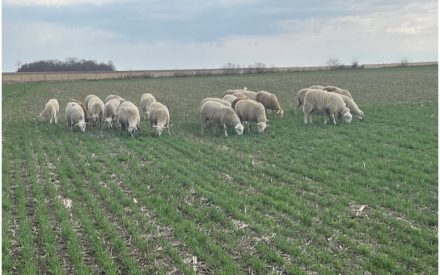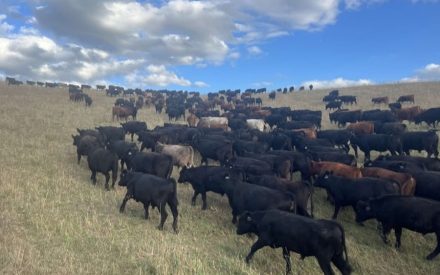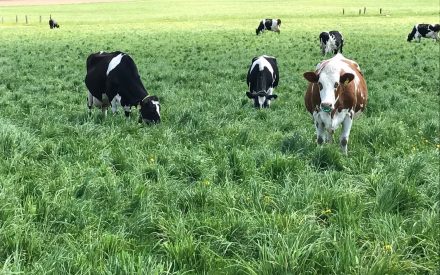This research brief was initially posted on Green Lands Blue Waters’ Match Made in Heaven: Livestock + Crops site.
What is crop and livestock integration?
Crop and livestock integration (integration) is a farm management strategy that combines production of livestock and annual crops on the same acres. Some integration practices include:
- Grazing cover crops
- Grazing crop residues
- Grazing annual or perennial forages
- Bale grazing on cropland
Historically, most Midwestern farms were integrated. Farmers utilized both pasture and crop resources to feed their livestock throughout the year. In recent decades, agriculture has shifted toward specialization, with larger farms focusing on a single enterprise, either livestock or grain.
Why integrate crops and livestock?
Enterprise specialization creates some efficiencies, but also some vulnerabilities. A shift towards integration can bring many benefits such as:
- Increased soil health and fertility
- Resilience to weather extremes
- Improved resource efficiency
- Opportunity for more family member involvement in the operation
One question remains; what are the financial implications of integration?
Economic Research
Background
Extension educators from across the Midwest collaborated to examine financial impacts of integration. The educators collected 2024 financial data from eleven integrated farms across four states (IA, MN, MO, and WI). These farms had an average size of 964 acres, with 32% in crops, 16% in hay, and 52% in pasture. The data were entered into FINPACK®, financial software from University of Minnesota’s Center for Farm Financial Management.
Integrated farms were compared to a similar dataset of crop-only farms from FINBIN©, a farm financial database that summarizes farm data from FINPACK® to provide financial benchmark information. The subset of croponly farms for this study included 601 farms across 3 states (MN, MO, and WI), with each managing between 501-1000 acres of cropland.
In comparing the integrated farms with the crop-only farms, the educators addressed the question: Are there financial benefits associated with integration?
Results
The following tables detail the average income (Table 1), expenses (Table 2), and net return (Table 3) of the collected crop-only and integrated farms in 2024.
Integrated farms earned an average of $54 more in gross income per acre than crop-only farms (Table 1). Although crop-only farms had more crop, crop insurance, and government payment income, integrated farms had even greater income from livestock sales and other on-farm income sources.
Table 1. Average income of crop-only and integrated farms on a per acre basis.
| Category | Crop-only | Integrated |
|---|---|---|
| Crop income | $620 | $147 |
| Livestock income | $0 | $538 |
| Crop insurance revenue | $71 | $17 |
| Government payments | $35 | $24 |
| Other | $4 | $59 |
| Gross income | $730 | $784 |
Crop-only farms had an average of $66 more per acre in expenses than integrated farms (Table 2). The largest difference in expenses was in the crops category. Integrated farms used about 68% of their land for forage crops which tend to have lower crop inputs, while crop farms used 100% of their land for annual crops which have higher fertilizer, ag chemical, and seed costs.
Table 2. Average expenses of crop-only and integrated farms on a per acre basis.
| Category | Crop-only | Integrated |
|---|---|---|
| Crop | $300 | $105 |
| Livestock | $0 | $181 |
| Whole farm | $266 | $156 |
| Overhead | $161 | $214 |
| Total expenses | $722 | $656 |
Overall, integrated farms saw an average of $120 more in net return per acre than croponly farms (Table 3). Integrated farms had greater gross income and fewer expenses.
Table 3. Summary of average gross income, total expense, and net return of crop-only and integrated farms on a per acre basis.
| Category | Crop-only | Integrated |
|---|---|---|
| Gross income | $730 | $784 |
| Total expenses | $722 | $656 |
| Net return | $8 | $128 |
Conclusion
Integration provides many agronomic benefits and can also improve farm financial resilience. Having both crops and livestock in a farm operation helps to balance out farm income when commodity prices change. In times when crop prices are low, high livestock prices can provide a financial buffer. Likewise, when livestock prices are low and crop prices are high, the crop enterprise can act as a financial buffer.
Specialization brings with it several benefits, but also significant risks. A sound financial strategy is to maintain a balance between short-term profit gains and long-term farm viability. While specialization might provide more short-term profits, integration provides greater long-term farm viability.
While integrated farms may require more intense management, multiple agronomic and financial benefits may justify the effort for many farmers.
For more information, visit z.umn.edu/CropLivestockIntegration.

 Managing Rust in Cool Season Pastures
Managing Rust in Cool Season Pastures Grazing Cover Crops and Annual Forages
Grazing Cover Crops and Annual Forages Grazing to Protect Surface Water: Considering critical and sensitive areas
Grazing to Protect Surface Water: Considering critical and sensitive areas ▶ Spring Grazing Checklist
▶ Spring Grazing Checklist


